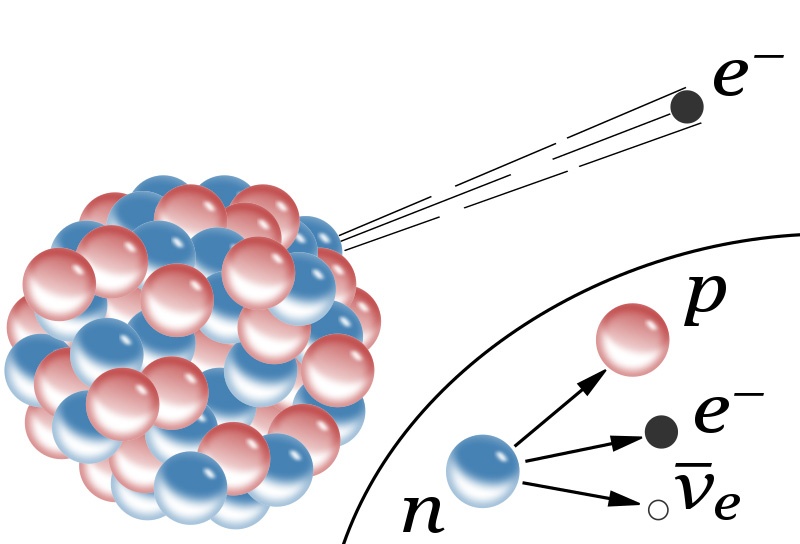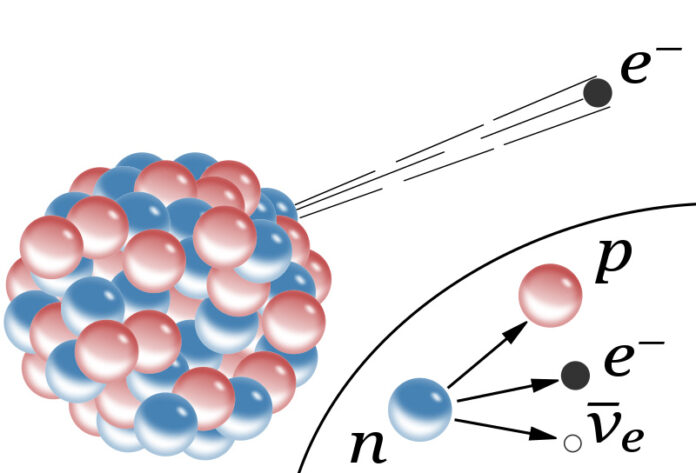T2K, a long-baseline neutrino oscillation experiment in Japan, has recently reported an observation where they have detected a strong evidence of a difference between fundamental physical properties of neutrinos and that of the corresponding antimatter counterpart, anti-neutrinos. This observation hints at explaining one of the biggest mysteries of science – an explanation for the domination of matter in the Universe over antimatter, and thus our very existence.
The matter-antimatter asymmetry of the Universe
According to the theory of Cosmology, particles and their antiparticles were produced in pairs from radiation during Big-Bang. Antiparticles are antimatters having nearly same physical properties as their matter counterparts i.e. particles, except for electric charge and magnetic properties that are reversed. However, the Universe exists and is made up of only matter indicates that some matter-antimatter symmetry was broken during the course of Big-Bang, because of which the pairs could not annihilate completely producing radiation again. Physicists are still looking for signatures of CP-symmetry violation, which in turn can explain the broken matter-antimatter symmetry in the early Universe.
CP-symmetry is the product of two different symmetries – charge-conjugation (C) and parity-reversal (P). Charge-conjugation C when applied on a charged-particle changes the sign of its charge, so a positively charged particle becomes negatively-charged and vice-versa. Neutral particles remain unchanged under the action of C. Parity-reversal symmetry reverses the spatial coordinates of the particle it is acting upon – so a right-handed particle becomes left-handed, similar to what happens when one stands in front of a mirror. Finally, when CP acts on a right-handed negatively-charged particle, it is converted into a left-handed positively-charged one, which is the antiparticle. Thus matter and antimatter are related to each other through CP-symmetry. Hence CP must have been violated in order to generate the observed matter-antimatter asymmetry, which was first pointed out by Sakharov in 1967 (1).
Since gravitational, electromagnetic as well as strong interactions are invariant under CP-symmetry, the only place to look for CP-violation in Nature is in case of quarks and/or leptons, that interact through weak interaction. Until now, CP-violation has been measured experimentally in the quark-sector, however, it is too small to generate the estimated asymmetry of the Universe. Hence understanding the CP-violation in the lepton-sector is of special interest to the Physicists to understand the existence of the Universe. The CP-violation in the lepton-sector can be used to explain the matter-antimatter asymmetry through a process called leptogenesis (2).
Why are the neutrinos important?
Neutrinos are the tiniest, massive particles of Nature with zero electric charge. Being electrically neutral, neutrinos cannot have electromagnetic interactions, and they do not have strong interactions either. Neutrinos have tiny masses of the order of 0.1 eV (~ 2 × 10-37kg), hence gravitational interaction is also very weak. The only way neutrinos can interact with other particles is through short-range weak interactions.
This weakly-interacting property of the neutrinos, however, makes them an interesting probe to study far away astrophysical objects. While even photons can be obscured, diffused and scattered by the dust, gas particles and background radiations present in the interstellar medium, neutrinos can pass mostly unhindered and reach the Earth-based detectors. In the current context, being weakly-interacting, neutrino-sector can be a viable candidate to contribute to the CP-violation.
Neutrino oscillation and CP-violation
There are three types of neutrinos (𝜈) – 𝜈𝑒, 𝜈𝜇 and 𝜈𝜏 – one associated with each lepton flavours electron (e), muon (𝜇) and tau (𝜏). Neutrinos are produced and detected as flavour-eigenstates via weak interactions in association with the charged lepton of corresponding flavour, while they propagate as states with definite masses, called mass-eigenstates. Thus a neutrino beam of definite flavour at the source becomes a mixture of all three different flavours at the point of detection after travelling through some path-length – the proportion of different flavour states being dependent on parameters of the system. This phenomenon is known as neutrino oscillation, which makes these tiny particles very special!
Theoretically, each of the neutrino flavour-eigenstates can be expressed as a linear combination of all three mass-eigenstates and vice-versa and the mixing can be described by a unitary matrix called Pontecorvo-Maki-Nakagawa-Sakata (PMNS) matrix (3,4). This 3-dimensional unitary mixing matrix can be parametrized by three mixing angles and complex phases. Of these complex phases, neutrino oscillation is sensitive to only one phase, named 𝛿𝐶𝑃, and it is the unique source of CP-violation in the lepton-sector. 𝛿𝐶𝑃 can take any value in the range −180° and 180°. While 𝛿𝐶𝑃=0,±180° means that neutrinos and antineutrinos behave identically and CP is conserved, 𝛿𝐶𝑃=±90° indicates a maximum CP-violation in the lepton-sector of the Standard Model. Any intermediate value is indicative of CP-violation at different degrees. Hence measurement of 𝛿𝐶𝑃 is one of the most important goals of the neutrino physics community.
Measurement of oscillation parameters
Neutrinos are produced in abundance during nuclear reactions, like those in Sun, other stars and supernovae. They are also produced in Earth’s atmosphere through the interaction of the high-energy cosmic rays with atomic nuclei. To have an idea of the neutrino flux, about 100 trillion pass through us every second. But we don’t even realize it since they are very weakly interacting. This makes the measurement of neutrino properties during the neutrino oscillation experiments a really challenging job!

To measure these elusive particles, neutrino detectors are large, having kilo-tons of mass and experiments take several years to achieve statistically significant results. Because of their weak interactions, it took the scientists about 25 years to detect the first neutrino experimentally after Pauli postulated their presence in 1932 to explain the energy-momentum conservation in nuclear beta decay (shown in the figure (5)).
Scientists have measured all three mixing angles with more than 90% precision at 99.73% (3𝜎) confidence (6). Two of the mixing angles are large to explain the oscillations of solar and atmospheric neutrinos, the third angle (named 𝜃13) is small, best-fit value being approximately 8.6°, and was measured experimentally only recently in 2011 by the reactor neutrino experiment Daya-Bay in China. In the PMNS matrix, the phase 𝛿𝐶𝑃 appears only in the combination sin𝜃13𝑒±𝑖𝛿𝐶𝑃, making experimental measurement of 𝛿𝐶𝑃 difficult.
The parameter that quantifies the amount of CP-violation both in quark and neutrino-sectors is called the Jarlskog invariant 𝐽𝐶𝑃 (7), which is a function of mixing angles and the CP-violating phase. For the quark-sector 𝐽𝐶𝑃~3×10-5 , while for the neutrino-sector 𝐽𝐶𝑃~0.033 sin𝛿𝐶𝑃, and thus can be upto three orders of magnitude larger than 𝐽𝐶𝑃 in the quark-sector, depending on the value of 𝛿𝐶𝑃.
Result from T2K – a hint towards solving the mystery of matter-antimatter asymmetry
In the long-baseline neutrino oscillation experiment T2K (Tokai-to-Kamioka in Japan), neutrino or antineutrino beams are generated at the Japan Proton Accelerator Research Complex (J-PARC) and detected at the Water-Cerenkov detector at Super-Kamiokande, after travelling 295km distance through Earth. Since this accelerator can produce beams of either 𝜈𝜇 or its antiparticle 𝜈̅𝜇, and the detector can detect 𝜈𝜇,𝜈𝑒 and their antiparticles 𝜈̅𝜇, 𝜈̅𝑒, they have results from four different oscillation processes and can perform the analysis to get efficient bounds on the oscillation parameters. However, the CP-violating phase 𝛿𝐶𝑃 appears only in the process when neutrinos change flavours i.e. in the oscillations 𝜈𝜇→𝜈𝑒 and 𝜈̅𝜇→𝜈̅𝑒 – any difference in these two processes would imply a CP-violation in lepton-sector.
In a recent communication, the T2K collaboration has reported interesting bounds on CP-violation in neutrino sector, analyzing the data collected during 2009 and 2018 (8). This new result ruled out about 42% of all possible values of 𝛿𝐶𝑃. More importantly, the case when CP is conserved has been ruled out at 95% confidence, and at the same time maximal CP-violation seems to be preferred in Nature.
In the field of high-energy physics, a 5𝜎 (i.e. 99.999%) confidence is required for claiming a new discovery, therefore next generation experiments are required to get sufficient statistics and higher precision for the discovery of the CP-violating phase. However recent T2K result is a significant development towards our understanding of the matter-antimatter asymmetry of the Universe through the CP-violation in the neutrino-sector, for the first time.
***
References:
1. Sakharov,Andrei D., 1991. ‘’Violation of CP invariance, C asymmetry, and baryon asymmetry of the universe’’. Soviet Physics Uspekhi, 1991, 34 (5), 392–393. DOI: https://doi.org/10.1070/PU1991v034n05ABEH002497
2. Bari Pasquale Di, 2012. An introduction to leptogenesis and neutrino properties. Contemporary Physics Volume 53, 2012 – Issue 4 Pages 315-338. DOI: https://doi.org/10.1080/00107514.2012.701096
3. Maki Z., Nakagawa M. and Sakata S., 1962. Remarks on the unified model of elementary particles. Progress of Theoretical Physics, Volume 28, Issue 5, November 1962, Pages 870–880, DOI: https://doi.org/10.1143/PTP.28.870
4. Pontecorvo B., 1958. INVERSE BETA PROCESSES AND NON-CONSERVATION OF LEPTON CHARGE. Journal of Experimental and Theoretical Physics (U.S.S.R.) 34, 247-249 (January, 1958). Available online http://www.jetp.ac.ru/cgi-bin/dn/e_007_01_0172.pdf. Accessed on 23 April 2020.
5. Inductiveload, 2007. Beta-minus Decay. [image online] Available at https://en.wikipedia.org/wiki/File:Beta-minus_Decay.svg. Accessed 23 April 2020.
6. Tanabashi M., et al. (Particle Data Group), 2018. Neutrino Masses, Mixing, and Oscillations, Phys. Rev. D98, 030001 (2018) and 2019 update. DOI: https://doi.org/10.1103/PhysRevD.98.030001
7. Jarlskog, C., 1986. Jarlskog Responds. Phys. Rev. Lett. 57, 2875. DOI: https://doi.org/10.1103/PhysRevLett.57.2875
8. The T2K Collaboration, 2020. Constraint on the matter–antimatter symmetry-violating phase in neutrino oscillations. Nature volume 580, pages339–344(2020). Published: 15 April 2020. DOI: https://doi.org/10.1038/s41586-020-2177-0
***




































